Welcome to this portfolio page. Here are some examples of the psychological tasks and serious games I've developed.
- Approach/Avoidance Task (AAT)
- Balloon Analogue Risk taking Task (BART)
- Implicit Association Task (IAT)
- Go/No-go task
- Self-Ordered Pointing Task (SOPT)
- Stimulus-Response Compatibility (SRC)
- Stop-signal task (STOP)
- Visual Dot-Probe Task (VPT)
- Visual Search Task (VST)
- Chessboard task
- Serious game: Cheese Ninja
- Serious game: Shots
- Serious game: RocketLauncher
- Serious game: CityBuilder
Notes:
- The descriptions of the tasks only pertain to the looks of the task, and don't detail the theories behind them, as this might influence potential participants. Also, most of these tasks are based on original designs by other researchers, as noted in the Further reading sections.
- The stimuli shown are taken from the Amsterdam Beverage Picture Set (ABPS), see Pronk, T., Van Deursen, D., Beraha, E., et al. (in revision). Validation of the Amsterdam Beverage Picture Set: a Controlled Picture Set for Cognitive Bias Measurement and Modification Paradigms.
- All tasks and games shown here were developed using Adobe Flash (ActionScript 3).
Approach/Avoidance Task (AAT) - Try it out
Assessment & re-training of (biased) automatic approach or avoidance tendencies
In the AAT the participant is presented with a sequence of picture stimuli of two categories (e.g., alcohol and soda beverages) that are either tilted 5 degrees to the left or to the right. Depending on this tilt, the instruction is to press the up- or down-arrow key until the picture disappears. Pressing the keys makes the picture zoom in (arrow down) or out (arrow up), simulating an approach / avoidance movement. The instruction is to react as quickly and as accurately as possible.

Further reading:
Rinck, M., Becker, E. S. (2007). Approach and avoidance in fear of spiders. Journal of Behavior Therapy and Experimental Psychiatry, 38, 105–120.
Wiers, R. W., Rinck, M., Dictus, M., et al. (2009). Relatively strong automatic appetitive action–tendencies in male carriers of the OPRM1 G–allele. Genes Brain and Behavior, 8, 101-106.
van Deursen, D. S., Salemink, E., Smit, F., et al. (2013). Web-based cognitive bias modification for problem drinkers: protocol of a randomized controlled trial with a 2x2x2 factorial design. BMC Public Health, 13, 674.
Back to top
Balloon Analogue Risk taking Task (BART) - Try it out
Assessment of risk taking behavior
In the BART the participant is presented with a sequence of 30 balloons, each of which can be pumped up to certain number of times, until they pop. Every pump is worth a point, but when the balloon pops (at predetermined points, unknown to the participant), no points are awarded.
Original build by Thomas Pronk.
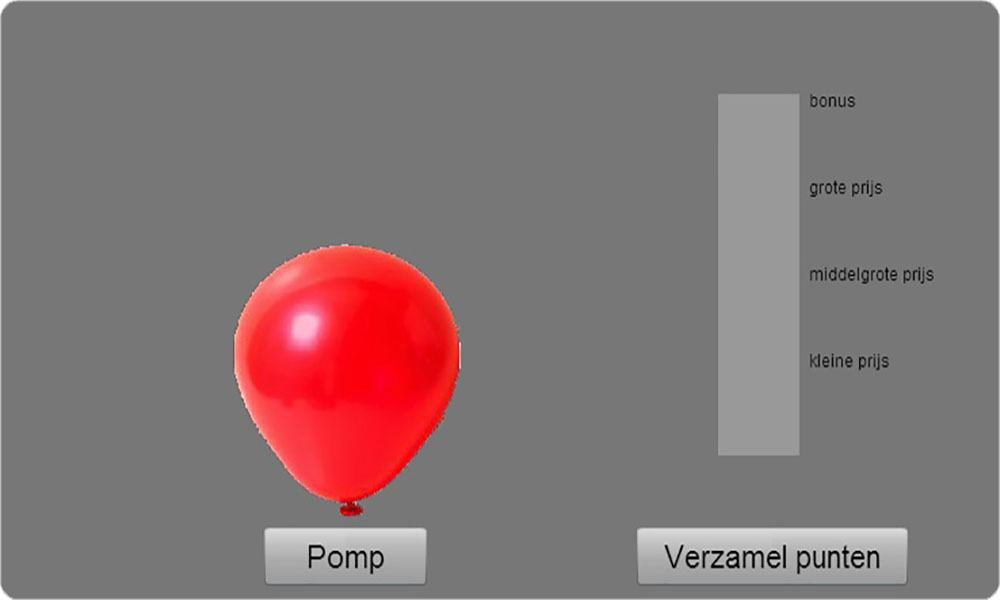
Further reading:
Lejuez, C. W., Read, J. P., Kahler, et al. (2002). Evaluation of a Behavioral Measure of Risk Taking: The Balloon Analogue Risk Task (BART). Journal of Experimental Psychology: Applied, 8(2), 75-84.
Back to top
Implicit Association Task (IAT) - Try it out
Assessment of implicit associations between categories
In the IAT the participant is presented with several sequences of stimuli (words and/or pictures) beloning to one of four categories (e.g., alcohol and soda beverages, and approach and avoidance). Over seven blocks, different combinations of categories are presented. Several variants are available, e.g., brief (bIAT), single target (STIAT), single category (SCIAT), as well as many variants using words or picture stimuli, etc.
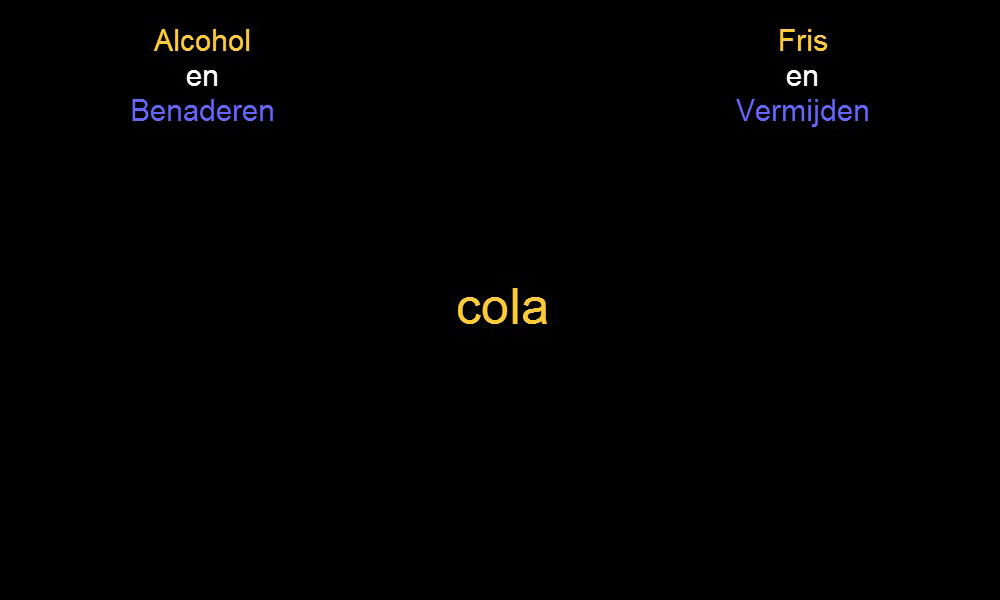
Further reading:
Greenwald, A. G., McGhee, D. E., & Schwartz, J. L. K. (1998). Measuring individual differences in implicit cognition: The implicit association test. Journal of Personality and Social Psychology, 74(6), 1464-1480.
Back to top
Go/No-go task - Try it out
Assessment & re-training of (biased) automatic response associations in memory / inhibitory processes
In the Go/No-go task the participant is presented with a sequence of picture stimuli of two categories (e.g., alcohol and soda beverages) with either the letter [P] or [F] in one of the corners. Depending on this letter, the participant should either hit the space bar as quickly as possible, or withold any response and wait until the stimulus disappears.
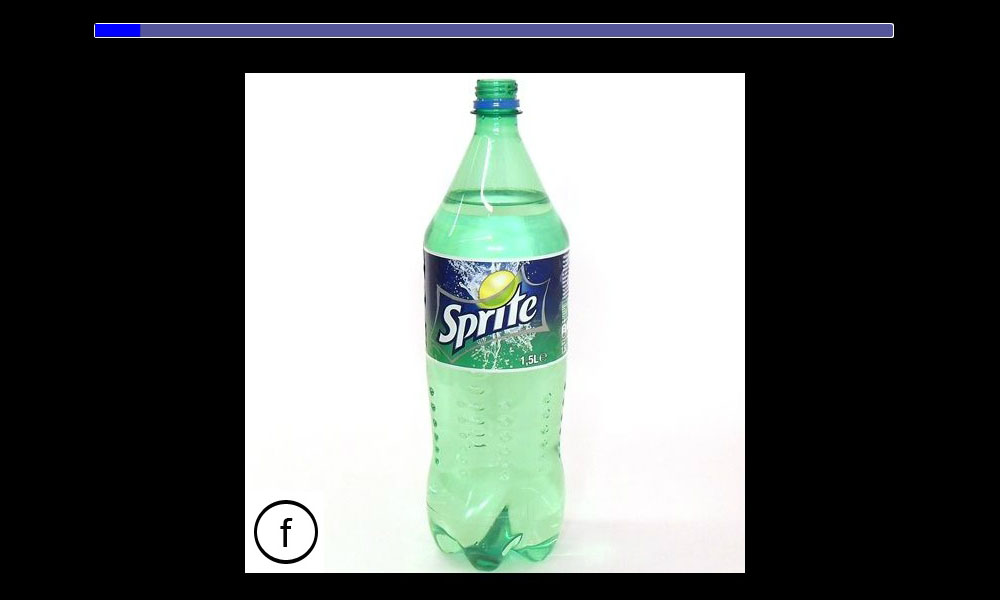
Further reading:
Houben, K., Havermans, R. C., Nederkoorn, C., et al. (2012). Beer á No-Go: learning to stop responding to alcohol cues reduces alcohol intake via reduced affective associations rather than increased response inhibition. Addiction, 107, 1280-1287.
van Deursen, D. S., Salemink, E., Smit, F., et al. (2013). Web-based cognitive bias modification for problem drinkers: protocol of a randomized controlled trial with a 2x2x2 factorial design. BMC Public Health, 13, 674.
Back to top
Self-Ordered Pointing Task (SOPT) - Try it out
Assessment of working memory
In this digital version of the SOPT the participant is presented with a fixed number of picture stimuli (either abstract or concrete). The instruction is to click on a unique picture; then the pictures all change places, and another unique picture should be clicked, unutil the number of pictures in the block has been reached.
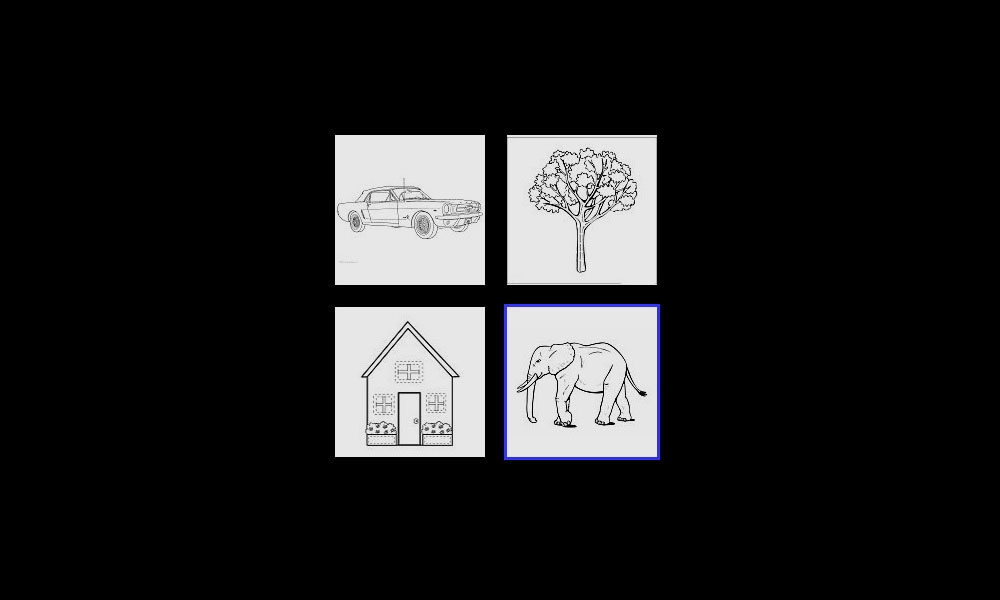
Further reading:
Petrides, M. & Milner, B. (1982). Deficits on subject-ordered tasks after frontal- and temporal-lobe lesions in man. Neuropsychologia, 20(3), 249-62.
Thush, C., Wiers, R. W., Ames, S. L., Grenard, J. L., Sussman, S., Stacy, A. W. (2008). Interactions between implicit and explicit cognition and working memory capacity in the prediction of alcohol use in at-risk adolescents. Drug and Alcohol Dependence, 94, 116–24.
Back to top
Stimulus-Response Compatibility (SRC) - Try it out
Assessment of (biased) automatic approach or avoidance tendencies
In the SRC the participant is presented with a sequence of picture stimuli of two categories (e.g., alcohol and soda beverages) that are presented either in the upper or lower half of the screen. In the opposite location there is a little manikin (stick figure). The instruction is to have the manikin walk either towards or away from a certain category of stimuli, depending on the block. The instruction is to react as quickly and as accurately as possible.
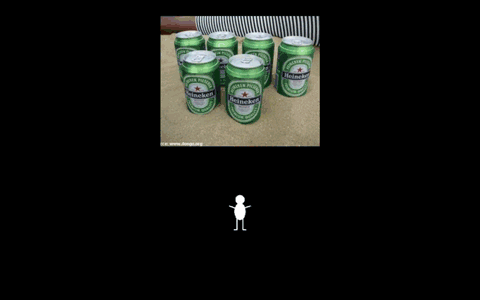
Further reading:
De Houwer, J., Crombez, G., Baeyens, F., et al. (2001). On the generality of the affective Simon effect. Cognition and Emotion, 15, 189-206.
Field, M., Kiernan, A., Eastwood, B., & Child, R. (2008). Rapid approach responses to alcohol cues in heavy drinkers. Journal of Behavior Therapy and Experimental Psychiatry, 39, 209-218.
Back to top
Stop-signal task (STOP) - Try it out
Assessment of inhibitory processes
In the STOP task the participant is presented with a white arrow, pointing either to the left or to the right. The instruction is to press the corresponding key on the keyboard (e.g., [Q] for left or [P] for right) as quickly as possible, unless the arrow turns red. Then no response should be given.

Further reading:
Logan, G. D. (1994). On the ability to inhibit thought and action: A user's guide to the stop paradigm. In: D. Dagenbach & T. H. Carr (Eds.), Inhibitory processes in attention, memory, and language (pp. 189-239). New York: Academic Press.
Logan, G. D., & Cowan, W. D. (1984). On the ability to inhibit thought and action: A theory of an act of control. Psychological Review, 91(3), 295-327.
Back to top
Visual Dot-Probe Task (VPT) - Try it out
Assessment & re-training of (biased) automatic attentional processes
In the VPT the participant is presented with a sequence of picture stimuli of two categories (e.g., alcohol and soda beverages) that are presented in pairs (one of each category). After a short interval, a small arrow is presented in the center of one of the two pictures (the pictures can either stay or disappear when this occurs). The instruction is react as quickly and as accurately as possible to the direction of the arrow (up or down) with the corresponding key.
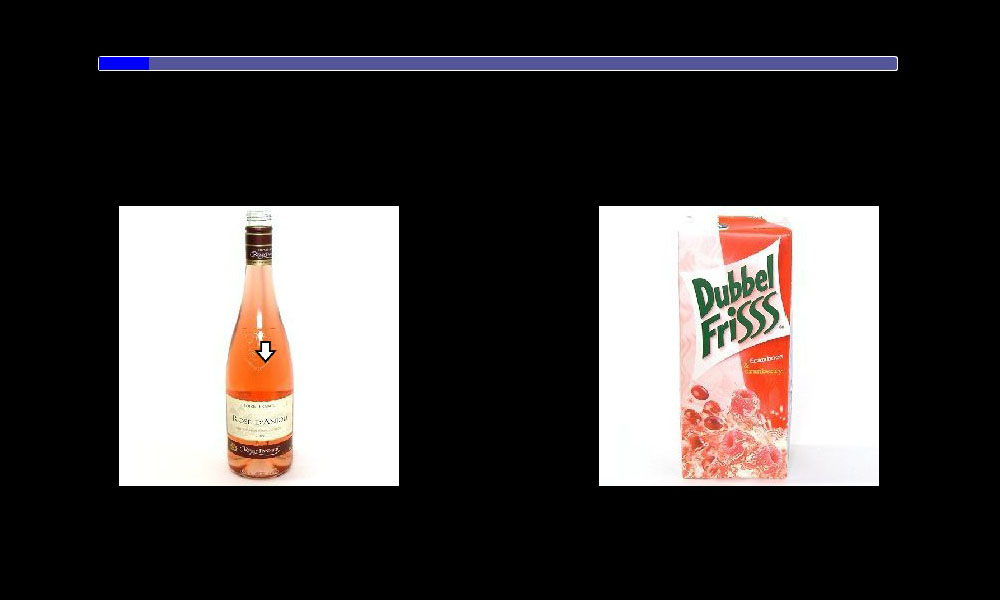
Further reading:
MacLeod, C., Mathews, A., & Tata, P. (1986). Attentional bias in emotional disorders. Journal of Abnormal Psychology, 95, 15–20.
van Deursen, D. S., Salemink, E., Smit, F., et al. (2013). Web-based cognitive bias modification for problem drinkers: protocol of a randomized controlled trial with a 2x2x2 factorial design. BMC Public Health, 13, 674.
Back to top
Visual Search Task (VST) - Try it out
Assessment and re-training of (biased) automatic attentional processes
In the VST the participant is presented with a sequence of grids of four by four picture stimuli of two categories (e.g., alcohol and soda beverages, or happy and angry faces): 15 of one category, and only 1 of the other. The instruction is to try to find and click on the minority picture as quickly and as accurately as possible. The target categories switch between blocks.
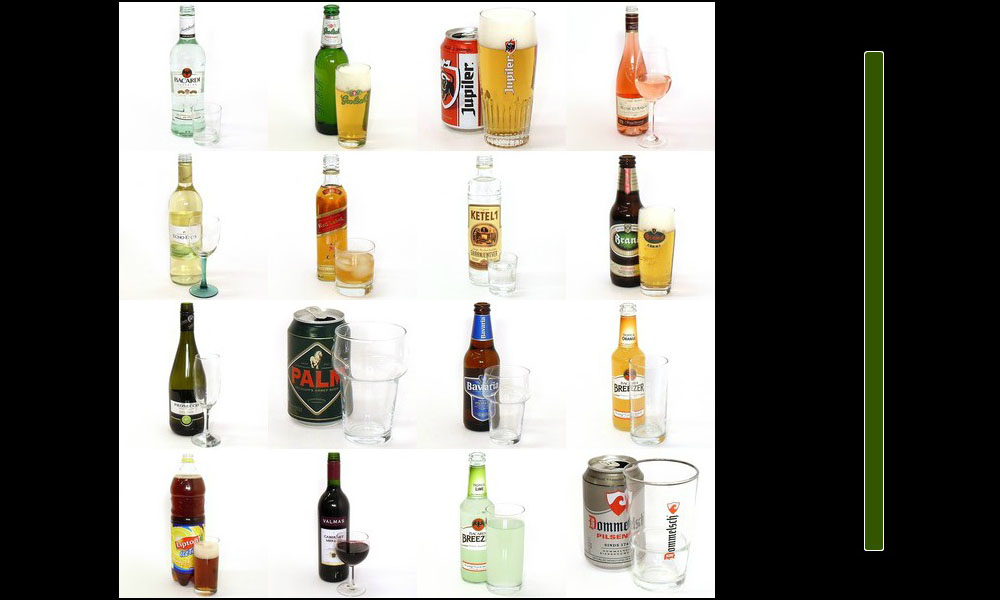
Further reading:
Dandeneau, S. D., Baldwin, M. W., Baccus, J. R., Sakellaropoulo, M., & Pruessner, J. C. (2007). Cutting stress of the pass: Reducing vigilance and responsiveness to social threat by manipulating attention. Journal of Personality and Social Psychology, 93, 651-666.
De Voogd, E. L., Wiers, R. W., Prins, P. J. M., & Salemink, E. (2014). Visual search attentional bias modification reduced social phobia in adolescents. Journal of Behavior Therapy and Experimental Psychiatry, 45, 252-259.
Back to top
Chessboard task - Try it out
Assessment and training of working memory
In the Chessboard task the participant is presented with a number of sequences, presented on a four by four grid of squares. A certain number of blocks light up and the sequence needs to be kept in memory and then re-arranged so that first the green squares, and then the blue squares are clicked.

Further reading:
Dovis, S., van der Oord, S., Wiers, R. W., & Prins, P. J. (2012). Can motivation normalize working memory and task persistence in children with attention-deficit/hyperactivity disorder? The effects of money and computer-gaming. Journal of Abnormal Child Psychology, 40, 669–681.
Back to top
Serious Games
Boendermaker, Prins and Wiers (2015) describe six gamification steps going from the evidence-based paradigms (e.g., the tasks shown above) towards Serious Games (and ultimately, off the shelf (OTS) games. For most cognitive tasks, the optimal level of gamification probably lies somewhere in the middle, e.g., Steps 2 and 4 below:
Cheese Ninja serious game
Based on a go/no-go paradigm for alcohol stimuli.
The Cheese Ninja Mouse Game on Facebook is an integrated-type game based on the Go/No-go paradigm. In this game, the player controls a Mouse character running through a tunnel, grabbing pieces of cheese and avoiding cats. Both are accompanied by 'posters' of alcohol and soda beverages on the background wall of the tunnel.
Credits:
Lead design & programming: Wouter Boendermaker (University of Amsterdam)
Students: Antonios Georgiadis & Ans de Nijs
Graphics: Wendelien Steltenpöhl
Back to top
Shots serious game
Based on a Visual Dot-Probe paradigm for alcohol stimuli.
The Shots game is an integrated-type game based on the Visual Dot-Probe paradigm, and looks like a slot machine-like game (without actual gambling elements!). The game features fancy graphics and animations, as well as an elaborate reward system with the intention to make the training task itself more motivating. To use the machine (i.e., to spin the wheels), participants need to spend a coin. When the wheels are done spinning, a small arrow appears on either side, and if the response is correct, the player can earn up to 3 new coins, based on the speed of the response. After a while, bonus pictures can show up, and the player can unlock new (visually different) machines.
Credits:
Lead design & programming: Wouter Boendermaker (University of Amsterdam)
Students: Sylvia van Schie, Soraya Sanchez, Guillaume Rensink & Aïda Alai
Graphics: Sylvia van Schie
Back to top
RocketLauncher serious game
Loosely based on attentional and approach/avoidance principles for alcohol stimuli.
The RocketLauncher game is an integrated-type game based loosely on several principles central to the theories behind some of the tasks described above (most notable, the AAT, SRC and VPT). The participant is encouraged to selectively attend to and approach certain neutral stimuli (e.g., soda beverages), while disengaging from and avoiding others (e.g., alcoholic beverages).
Credits:
Design & programming: Wouter Boendermaker & Rosanne Joosten (University of Amsterdam)
Based on original BombDodger game design by Thomas Pronk
Back to top
CityBuilder serious game
Shell game including several training paradigms
The Citybuilder Game is a so-called shell-type game, which means that the original training tasks are presented inside a game shell. An important advantage of this game type is that it incorporates several different training tasks. Players can train working memory, inhibition, approach and attention. Participants receive points during training for speed and accuracy, which can be spent between training blocks, buying a variety of objects to build a custom city. The game also includes social features, as well as daily achievements.
Further reading:
Boendermaker, W. J., Prins, P. J. M., & Wiers, R. W. (2015). Cognitive Bias Modification for Adolescents with Substance Use Problems – Can Serious Games Help? Journal of Behavior Therapy and Experimental Psychiatry.
Credits:
Design & programming: Wouter Boendermaker (University of Amsterdam)
Graphics: Elisabeth Enthoven
The first part of the video shows a regular, embedded training (Visual Dot-Probe is shown here).
The second part of the video shows the game shell (0:33).
Back to top